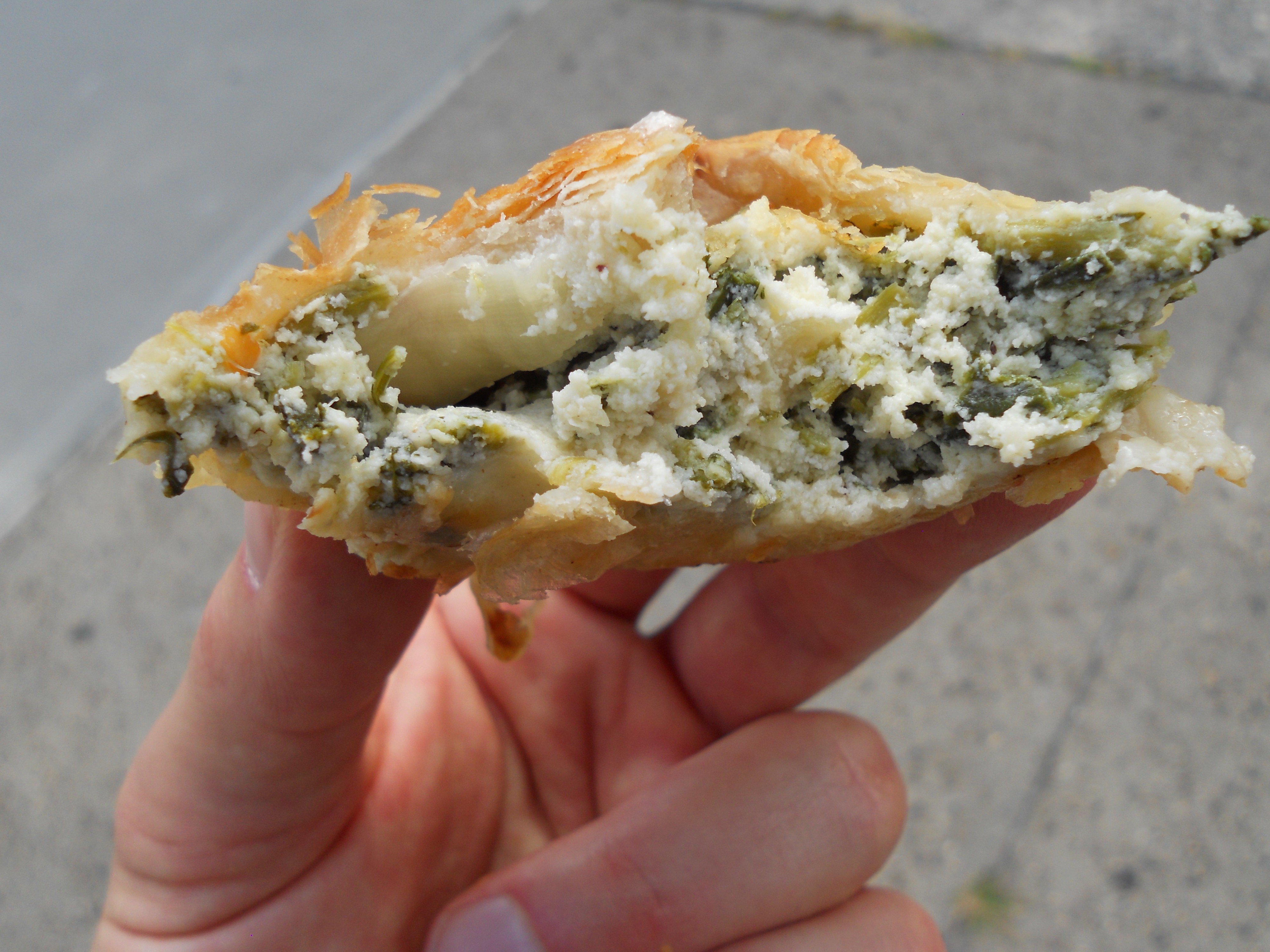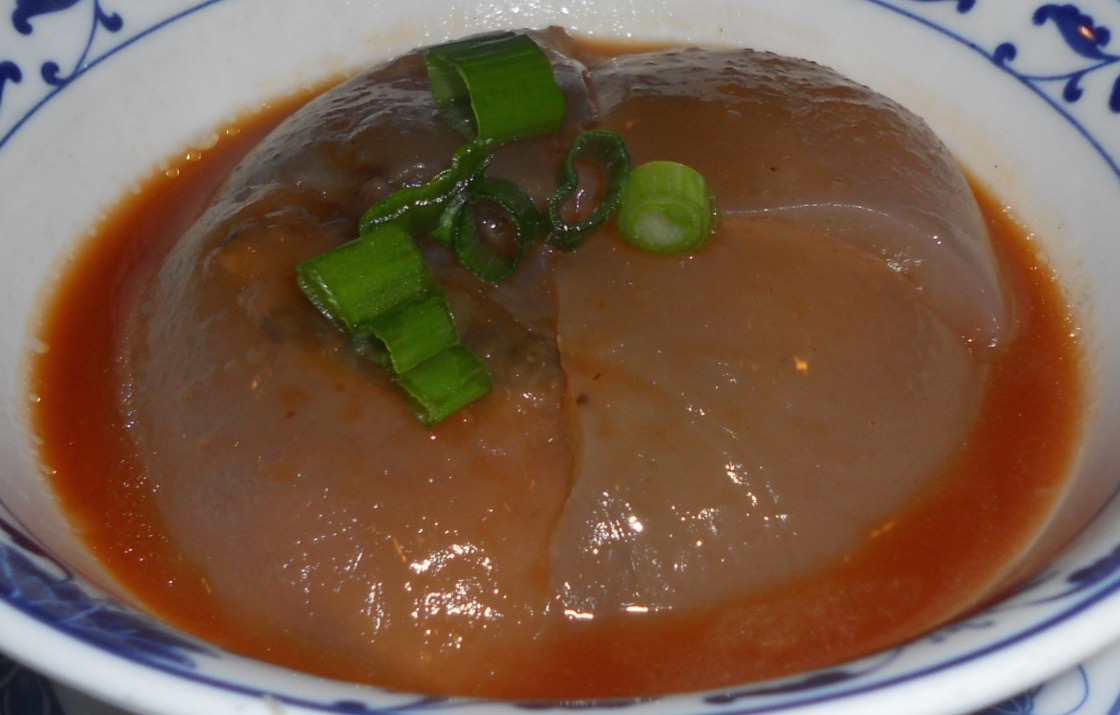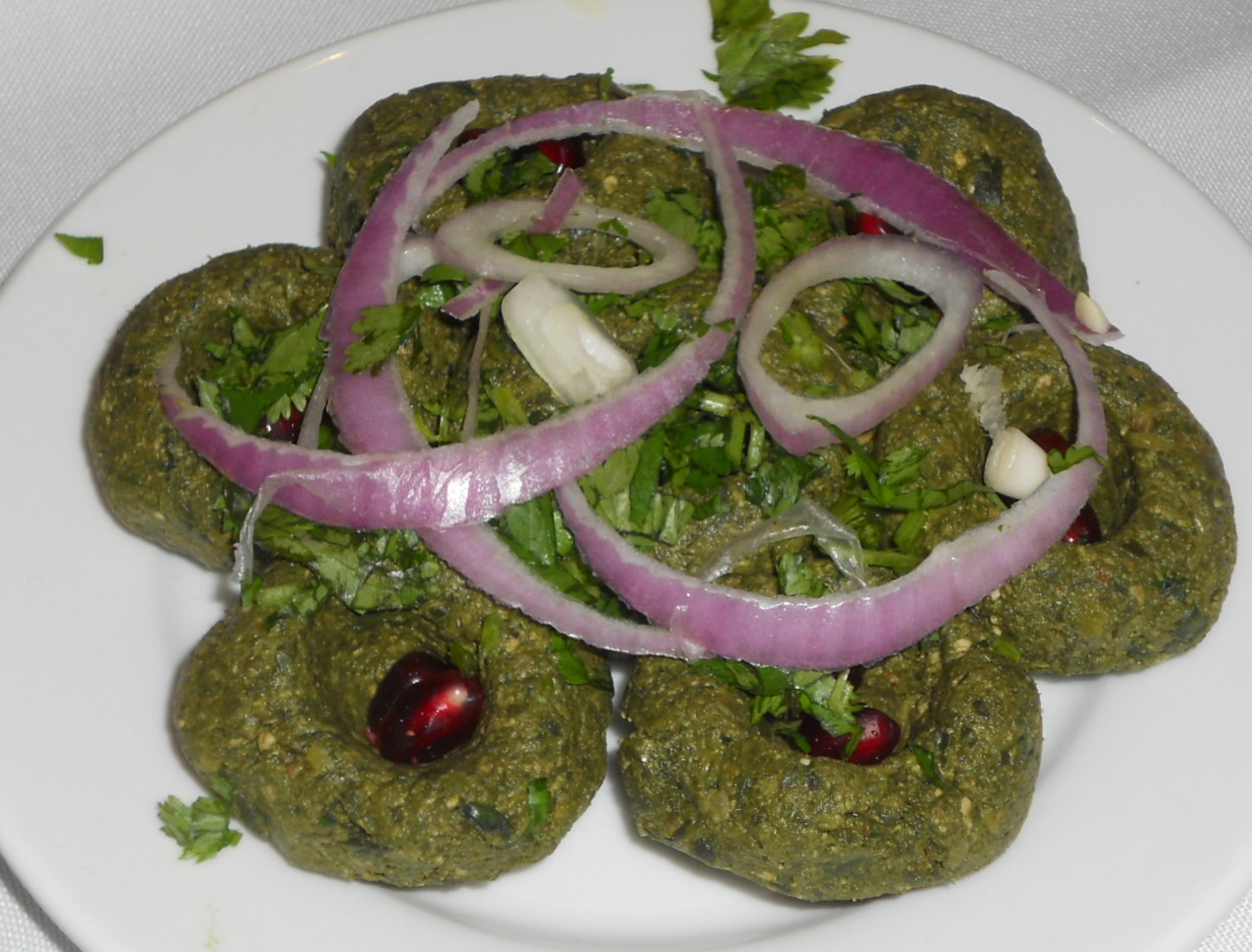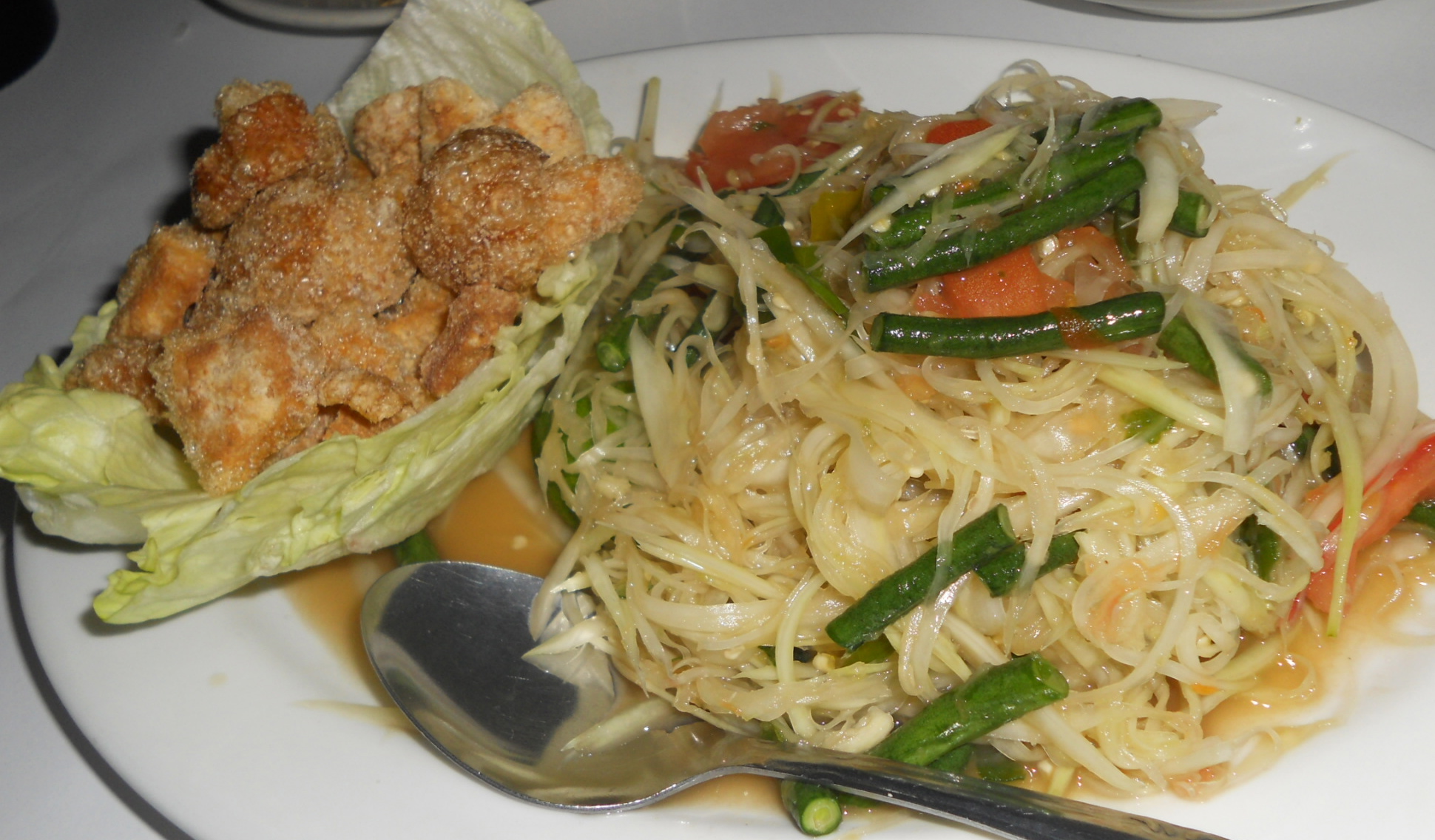|
|
You might have noticed that I really like food. You might also have noticed that I very rarely eat home-cooked meals.
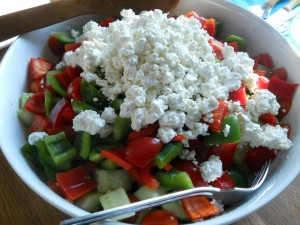 dill-sprinkled Bulgarian flag, anyone? For those of you who don’t live in Manhattan, here’s some exciting news: this island is effing expensive. So we rented a slightly flawed apartment to save money: there’s no direct sunlight and no kitchen, just a microwave, a cranky hot plate, and a tiny sink (9”x11”) that’s barely larger than a standard sheet of copy paper.
(Sacrificing a kitchen is arguably worth it—if you live in NYC and I tell you how little we pay in rent, you’ll want to kill me out of jealousy. If you don’t live in NYC and I tell you how much we pay in rent, you’ll want to kill me, because I’m clearly too stupid to deserve to live.)
You can do some pretty cool sh*t with a microwave these days (like marshmallow peep jousting), but eating out is usually a better option than eating frozen burritos or microwave-singed marshmallow peeps. Legit home-cooked meals are special treats, usually enjoyed only when we take a trip out to “the countryside”.
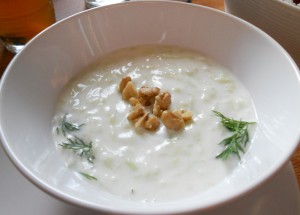 tarator, without fizzy fermentedness Living in Midtown Manhattan, we think of places like Brooklyn and Iowa as “the countryside.” They have quaint, kitschy country stuff like backyards. And direct sunlight. And kitchens.
Lucky for me, Phil The Bulgarian, an old pal from high school, lives in “the countryside” in Brooklyn, and he and his wife (we’ll refer to her as Jasmina The Almost-Bulgarian) generously agreed to prepare a home-cooked Bulgarian meal for us. Home-cooked food?!? Truly exotic, even if it doesn’t come in a ziplock bag.
We warmed up with tarator, a deliciously fresh yogurt-cucumber soup, sprinkled with dill and walnuts. It reminded me of Azeri dovga, except that the yogurt wasn’t fermented and the soup lacked dovga’s fizzy fermented taste… and the walnuts also added a nice crunch. We followed the soup with shopska salad, made from a mix of green peppers, red tomatoes, and white feta cheese, mimicking the colors of a dill-sprinkled Bulgarian flag. (No disrespect meant toward Bulgaria or any other country, but I would probably eat more flags if they were sprinkled with dill.)
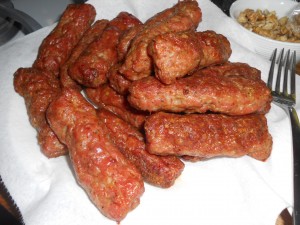 kebapche For our main course, Phil The Bulgarian and Jasmina The Almost-Bulgarian spoiled us rotten with some incredibly tasty kebapche (Bulgarian sausage, similar to cevapi served throughout the Balkans), with a beautifully crispy casing—definitely a huge step up from the cevapi I’ve eaten in Bosnian and Serbian and Montenegrin places. We also enjoyed a heap of golden potatoes (kartofki), roasted with dill, based on a recipe from Phil The Bulgarian’s father.
I could have happily chomped on the kebapche and dilled potatoes all night, but our Bulgarian hosts outdid themselves by feeding us an amazing dish with a brief, thoroughly anglicized, easy-to-pronounce name: Pulni Chushki na Lili Milanova. I think the translation is “stuffed peppers with a few extra words.” The peppers were stuffed with a dill-egg-feta cheese mixture, and they were extremely lovable. So lovable, in fact, that I’m posting the recipe over here—and that’s a United Nations of Food first, since I’m generally way too lazy (and kitchen-deprived) to bother collecting recipes.
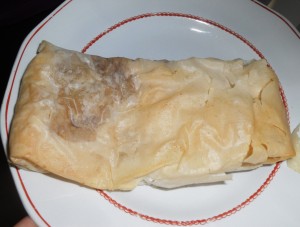 non-disastrous, backlash-free Bulgarian dessert Jasmina The Almost-Bulgarian even spoiled us rotten with an amazing dessert called banitsa, a distant cousin of baklava, consisting of a tasty pumpkin filling baked inside a soft pocket of phyllo dough. I thought it was absolutely delicious, though Jasmina The Almost-Bulgarian poked at it apologetically before the meal: “Sorry, it looks like crap—I’ve never made it before, and I don’t know how to fold the phyllo dough.” She even asked that I refrain from publishing the recipe, “for fear of a backlash.”
If the delicious banitsa is Bulgaria’s version of a backlash-worthy kitchen disaster, then Bulgaria must be pretty damned awesome. Someday, when (if?) I ever grow up, maybe I’ll have my own kitchen in the “countryside,” just like Phil The Bulgarian and Jasmina The Almost-Bulgarian. And if my kitchen “failings” look anything like theirs, I’ll be a happy, well-fed man.
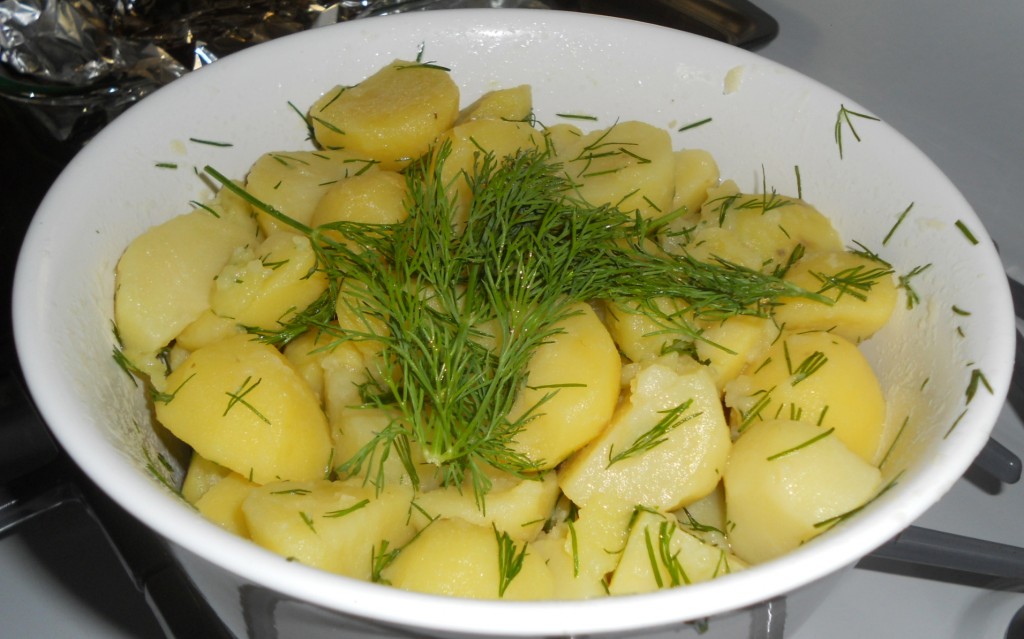 yes… happy and well-fed
|
|
|
Urbanspoon lists 1836 Italian restaurants in NYC. If you search for NYC Italian restaurants on yelp, you’ll find 2659 options. And if you google the term “NYC Italian restaurants”, you’ll get 50,200,000 results.
So yeah, there are somewhere between 1836 and 50,200,000 Italian restaurants in NYC. And I passed up all of them for Cacio e Vino, a Sicilian place in the East Village.
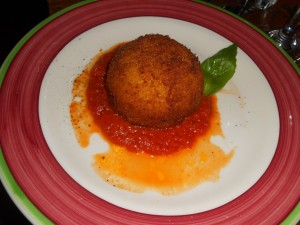 a small meaty ball, not a giant pecorino This better be effing good.
We picked on Cacio e Vino mostly because a friend heartily recommended a dish called cacio e piselli, which consists of spaghetti and peas served inside a massive wheel of pecorino cheese. That sounded awesome. Was the giant pecorino wheel going to be mostly hollowed-out, with only the rind intact? Or would we be able to chip off chunks of the giant pecorino to mix into our pasta? It all sounded very exciting.
Before we would have the chance to experience the pleasures of the giant pecorino, we had to endure some foreplay with the appetizer menu. Since we were in a Sicilian place, we asked our charming Sicilian server to steer us toward her favorite Sicilian treats.
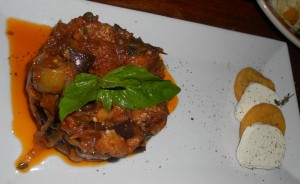 tasty eggplant pre-pecorino foreplay She specifically recommended the arancini—fried balls stuffed with rice, ground beef, and spices ($7.95). They were far tastier than, say, fried butter on a stick, but arguably less interesting. However, our salads—a sweet-and-sour eggplant caponata with chickpea fritters and goat cheese ($11.95) and a tossed salad with mandarins and fennel ($9.95)—were excellent, and a perfect way to whet our appetites before we attempted to stuff the giant pecorino in our mouths.
When the giant pecorino finally arrived, we were mildly disappointed. I mean, it was definitely large enough. In fact, it was unquestionably the broadest, thickest, roundest pecorino I’d ever seen in my life. But the waiter simply mixed up the spaghetti inside the pecorino’s small hole, transferred it into a bowl, and took the giant pecorino back to the kitchen.
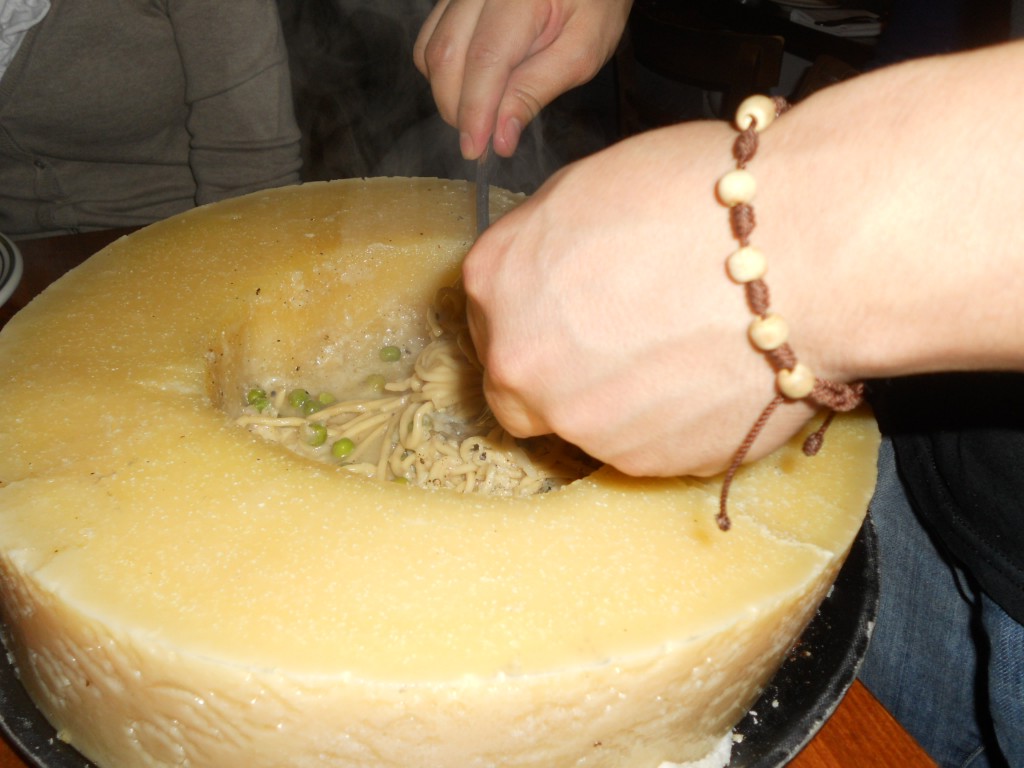 the giant pecorino, posing with peas, pasta, and two skillful hands
The unveiling of the giant pecorino left us with more questions than answers. Did the pasta-hole in the giant pecorino slowly expand over time, accommodating ever-larger portions of spaghetti? How did they keep the giant pecorino clean? By running it through a dish machine, or just with an occasional, slow rubdown?
As it turns out, the pea-drizzled pasta inside the giant pecorino (cacio e piselli, $13.95) was peppery and delicious, but the portion was lamentably small. We also ordered a Sicilian pasta dish with anchovy and fried egg (spaghetti alla siciliana, $16.95), which was also delicious, but small. So we ordered a third pasta dish with mint and tuna (busiate con tonno, $19.95), which was also delicious, and also small.
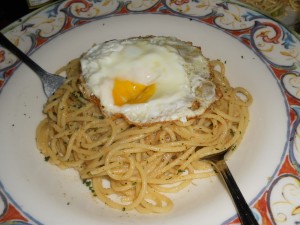 not giant, but at least the fried egg is pretty We followed our three plates of pasta with an order of Sicilian flatbread topped with cheese, sausage, and red peppers (schiacciata piccante, $14.95), just to make sure that nobody went home with that empty feeling that can only result when you haven’t been sufficiently stuffed by the giant pecorino. And for once, the restaurant surprised us with a massive plate of food. The flatbread wasn’t earth-shattering, but it had been pulled straight from an oven located less than 15 feet from our table, and all of the toppings were ludicrously fresh.
The bill came to $60 per person, include a generous tip, a couple of petite shared desserts, and two drinks each. Sixty bucks is fairly normal for a nice meal in the East Village, but an epic, miserable ripoff compared to my usual hole-in-the-wall favorites.
To be fair, all of my (lightweight) companions were moaning and groaning about how full they were after the meal. We even had a big chunk of sausage-stuffed Sicilian flatbread leftover from the meal. I happily ate it on the walk home, but wondered if I would have been even happier and fatter somewhere on Arthur Avenue in the Bronx. Next time I need an Italian fix, I’ll search the boogie down for a bigger, thicker, more satisfying pecorino.
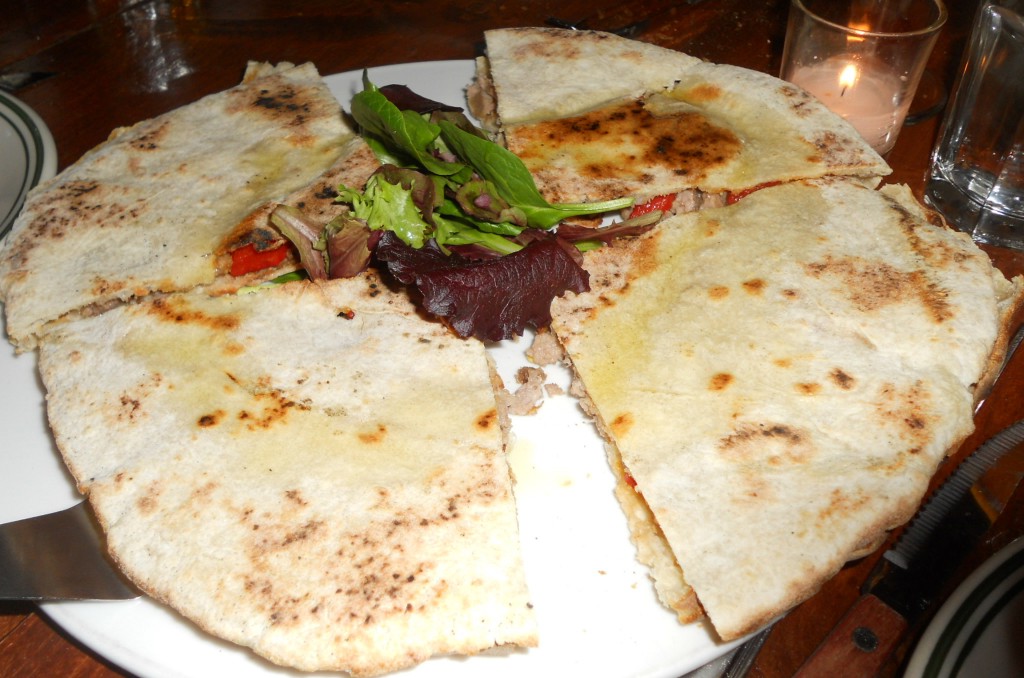 at least the flatbread was thick with sausage 
Cacio e Vino
80 2nd Avenue, East Village
Subway: 2nd Ave. (F train) or Bleeker (6 train) or Astor Pl. (6 train)
|
|
|
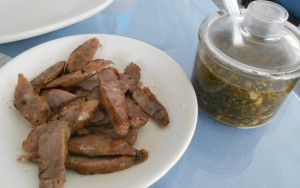 cow: the warning shot And then, there was cow.
If you walk into La Esquina Criolla and order a “parillada completa” (rough translation: complete grilled Argentine cow), you’ll receive cow–specifically, a salty, fennel-y beef sausage–as an appetizer. That’s the grill man’s version of a culinary warning shot.
Ten minutes after the beef-sausage warning shot, the grill man completely opens fire: three more types of cow sausage, accompanied by cow skirt steak, cow flank steak, cow kidneys, cow hearts, cow sweetbreads, cow intestines, and random pieces of cow gristle, all on a sizzling metal grill powered by a few hot coals.
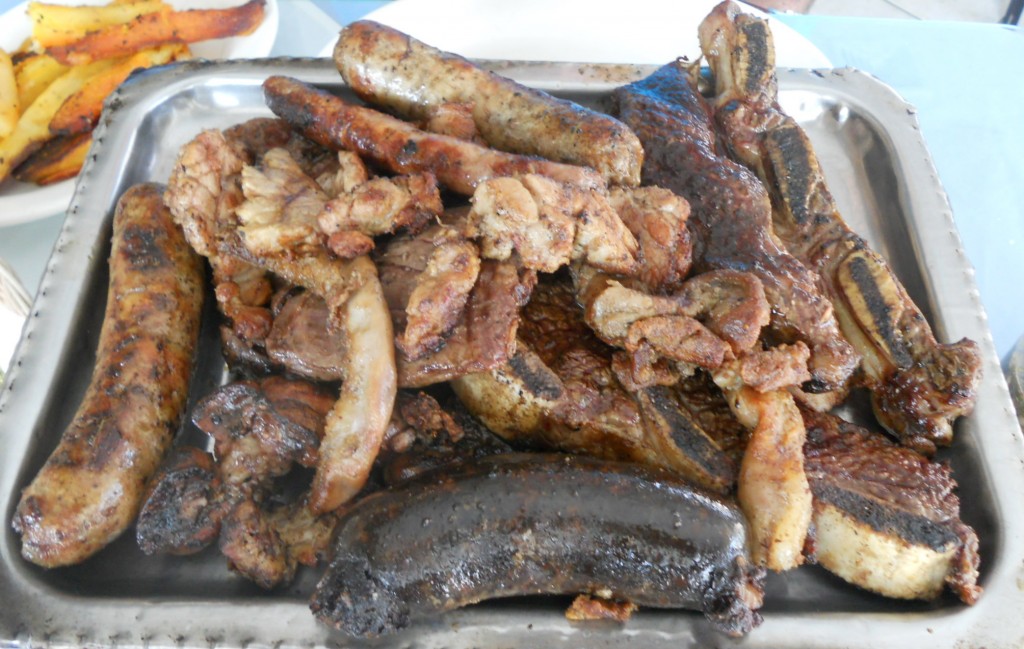 anybody want some cow parts? It’s hard to go wrong with grilled cow, especially when the cow has been prepared by Argentines, who are arguably the world’s foremost experts in tasty cow preparation. Each part of the cow—even the unidentifiable gristly chunks—was marinated and grilled to perfection. The skirt steak was particularly delicious, and I became a fan of an unidentifiable organ meat—kidney, I think—which was whitish and ludicrously tender, and reminded me of non-rubbery, non-fishy grilled scallops.
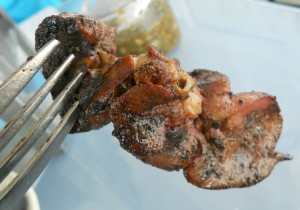 let’s play everybody’s favorite game: name that cow part! (Wait, what’s that? You don’t want your grilled cow to remind you of grilled scallops? OK, fine. It reminded me of tender, flaky white-meat cow. How’s that? Better?)
For a mere $39.90, our massively delicious mountain o’cow was accompanied by roasted yellow potatoes, a salad (yeah, I know—why bother with salad when you have four kinds of beef sausage?) freshly grilled bread, and a spectacular Argentine chimichurri sauce, made with garlic, olive oil, and craploads of minced parsley. The meal is designed for two people, but we struggled to get through the last few chunks of sausage and innards; it was just too much food, despite the fact my dining companion is from Rochester, and regularly eats the legendary Rochester garbage plate (macaroni salad and fried potatoes, topped with two cheeseburgers or two hot dogs, then covered in a spicy meat sauce).
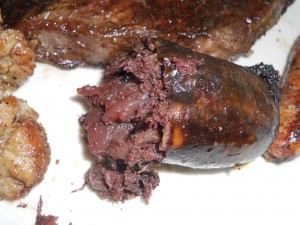 c’mon, Rochester dude: blood sausage is sort of like a bovine garbage plate, stuffed inside an intestine So yeah. Rochester dude can knock down something called a garbage plate, but can’t handle his half of the Argentine grilled cow. Good job, Argentina. Final score: Argentina 1, Rochester 0.
Since my Rochester pal was such a wuss, I didn’t invite him for ice cream afterward. As it turns out, there’s an Argentine ice cream shop called Cones, located on an expensive-looking street in the West Village.
Cones, like most ice cream shops in Argentina, features a creative array of flavors, including grapefruit sorbet (which tastes like beautifully bitter grapefruit), ginger sorbet, and Johnny Walker ice cream, made from a blend of scotch and macerated kumquats.
But I was particularly excited about the yerba mate ice cream. Yerba mate, in case you aren’t already a fan, is a fabulously strong green tea popular in Argentina, Uruguay, and Paraguay. Apparently, it doesn’t actually contain caffeine, but instead contains a delicious, amphetamine-like stimulant, which is particularly appealing if you’re slightly drunk from scotch ice cream. I’ve always loved yerba mate, though it sometimes makes me act like this guy.
And yerba mate blended into ice cream? One mildly overpriced bowl ($6.95 for a large) kept me awake for three nights straight, and it gave me the energy to run the Indianapolis 500 without a vehicle. OK, so maybe I’m making that last part up. But it was a perfect antidote to a cow-induced food coma.
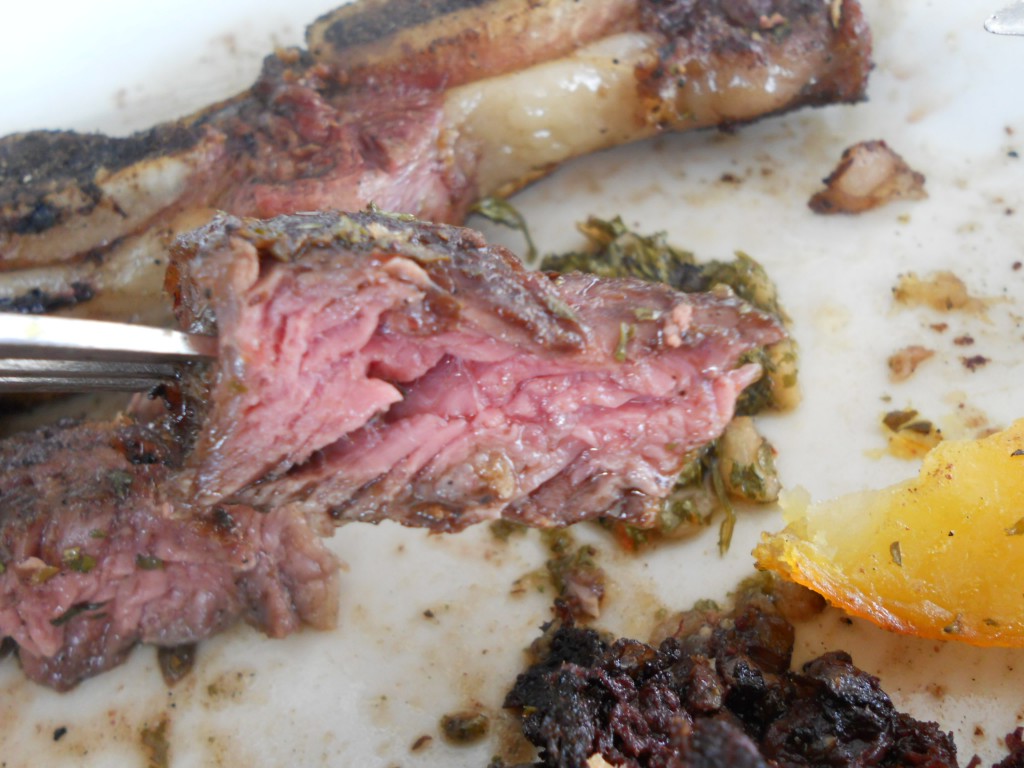 I have a feeling that somewhere in Buenos Aires, an Argentine culinary genius is perfecting his recipe for beef-flavored ice cream… 
La Esquina Criolla
9467 Corona Ave., Queens
Subway: Junction Blvd. (7 train)

Cones
272 Bleecker St., Manhattan
Subway: W 4th St. (A, B, C, D, E, F, M trains) or Christopher St-Sheridan Sq. (1 train)
|
|
|
OK, fine. I admit it: sometimes, I totally stalk people. But only if I think they might be able to feed me something interesting.
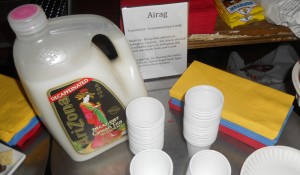 real fermented Mongolian milk is way more interesting than fake Mongolian BBQ, yes? Once upon a time, I was hungry, and tried really hard to stalk real Mongolians in New York City. Unfortunately, I couldn’t find any. (In case you’re wondering: corner-store “Mongolian BBQ” was invented by a Taiwanese marketing genius in the 1970s, and it bears zero resemblance to actual Mongolian food.)
Since Mongolians appeared to be scarce in NYC, I resorted to twitter-stalking an American writer named Patricia Sexton, who briefly worked as a news anchor in Ulaanbaatar. Since she writes an amazing blog called LIVE from Mongolia—and since she’s about to publish a full-length book about her Mongolian adventures—I figured that she might, somehow, lead me to some tasty Mongolian food.
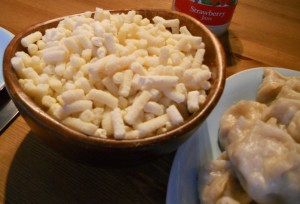 worm aaruul, without the worms That worked, sort of. Several months after I started stalking her on twitter, I was in Patricia’s kitchen, making homemade Mongolian cheese. That same week, I spent an evening in the home of some friendly Mongolians in New Jersey, eating fresh lamb dumplings, milk tea, and a tasty cheese curd-type substance called “worm aaruul.” And a few nights before that, I was in a Mongolian store in Virginia, buying deep-fried Mongolian butter cookies and Mongolian meat tea. And then we fed Mongolian food to a crowd of friends and strangers, and raised almost $1600 to help a struggling Mongolian family.
This twitter-stalking thing can be pretty cool, I guess.
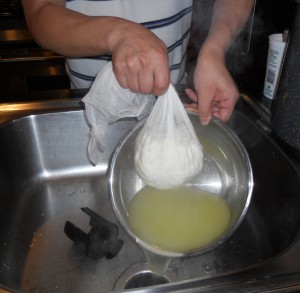 fresh Mongolian cheese (byaslag), in the early stages of pressing If you’re a regular reader of this blog, you probably already know the story: Patricia’s blog introduced the world to Urangoo, a 13-year-old Mongolian contortionist whose father was killed in a gold mine. Urangoo’s full story can be found here, but Patricia and I decided—before we even met each other in person—that it would be fun to try to help Urangoo and her family by organizing a food-friendly Mongolian fundraiser. We contacted the Mongolian consulate, and they introduced us to Byambakuu Darinchuluun, a Mongolian cultural scholar and event organizer, who spent dozens and dozens of hours introducing us to Mongolian food and culture.
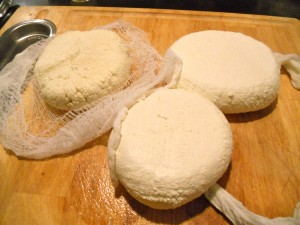 byaslag, post-pressing It was a ton of fun to listen to Byambakuu smash my lame stereotypes of Mongolian food. Surprisingly, the traditional rural Mongolian diet includes relatively little fresh meat. Meat is reserved for special occasions, and most herding families slaughter livestock only in November, when they freeze and dry the meat for later consumption. Vegetables are a seasonal luxury for most Mongolians, and their diet revolves around milk products, including yoghurt, dried cheese curds (aaruul), fresh cheese (byaslag), and fermented mare’s milk (airag).
And lemme tell ‘ya, it’s not easy to find most of this stuff in the United States. Byambakuu and I traveled to Arlington, Virginia, just to visit AmEx, a small Mongolian grocery store, where we picked up boortsog (deep-fried Mongolian butter cookies), a couple of packets of dried meat tea (yes, you read that correctly), and America’s best attempt at fermented mare’s milk… in this case, fermented cow’s milk, stored in repurposed Arizona tea jugs.
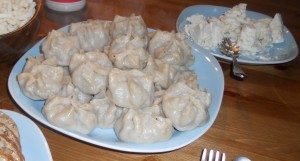 OK, I’ll eat buuz Two days later, Byambakuu took me to the home of Mrs. Myagmar-Dari, a legendary Mongolian dumpling-maker in New Jersey. In theory, we were just buying lamb dumplings (called buuz) from her, but she and her husband insisted that we sit down for a cup of Mongolian milk tea. And then things got totally awesome: they served the tea with an incredibly rich, coarse buttercream called urum, which is made only in Mongolia from unpasteurized milk. They also offered an unusual flour-like substance (similar to Tibetan tsampa) which Mongolians add to the tea to give it some extra heft.
And it got better: we drank a few shots of Chinggis vodka (named after Genghis Khan), and snacked on something called “worm aaruul.” Aaruul is a type of hard, dried cheese curd; worm aaruul is made with a little bit of sugar, and it’s run through a meat grinder to give it a soft texture and a “wormy” contour. It was pretty tasty, and resembled a lightly sweetened Parmesan cheese. And of course, there were huge piles of fresh lamb dumplings, which were absolutely incredible. And Mrs. Myagmar-Dari wasn’t shy about feeding me: “You eat buuz!” she insisted, shoving more delicious dumplings onto my plate.
Suddenly, I was in love with Mongolia.
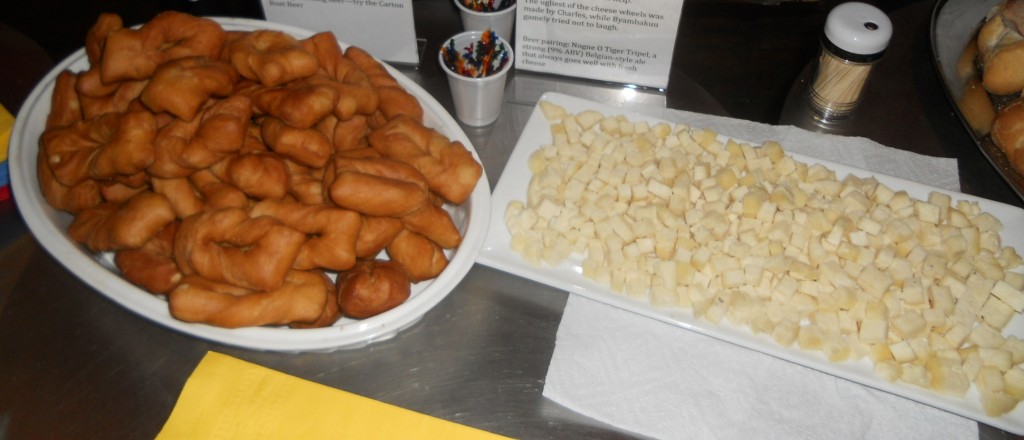 deep-fried Mongolian butter cookies (boortsog) and fresh Mongolian cheese; the ugly brown bits of cheese are the dumb American’s fault Two nights later, Byambakuu taught us how to make fresh Mongolian cheese. We boiled a gallon of whole milk, and then slowly stirred a quart of yogurt into the milk. We strained the resulting brew, and squeezed the chunky cheesy bits through cheesecloth, kneading and pounding the ball of cheesy chunky stuff until all of the liquid was gone.
The result can be eaten immediately, though Byambakuu said that the cheese tasted best after it dries for three days or so. We made five wheels of cheese, four of which were beautiful, and tasted like pleasantly fatty, unsalted mozzarella cheese. Byambakuu insisted that I make one cheese wheel entirely by myself; it was oddly brown, chunky, burnt-tasting, and misshapen. Oops, I completely failed my first Mongolian cooking test.
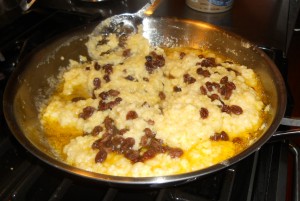 fresh khailmag (burnt Mongolian fingers not shown) We also made a dessert called khailmag, made from a mixture of shortening, water, flour, and sugar, pan-fried at a ridiculously high temperature until clarified oil separates at the sides of the pan. Reconstituted raisins are then added to the mix, and the result is a warm, delicious sludge that resembles a not-too-cheesy cheesecake.
Once we finished our multi-state quest for fresh Mongolian cuisine, we piled into a bar in the East Village, and fed fermented milk, homemade Mongolian cheese, deep-fried butter cookies and fresh dumplings to a small crowd of donors. Mrs. Myagmar-Dari, our beloved Mongolian dumpling-maker, made my day by shoving yet another plate of hot lamb dumplings into my hands. “You eat buuz!” she insisted, with a huge grin on her face. How could I refuse?
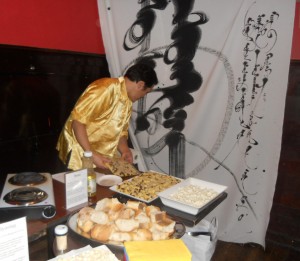 Byambakuu, my favorite Mongolian food expert, with Mongolian calligraphy While we munched our dumplings, Urangoo, the young contortionist, did an amazing live performance via skype—at 3:00 a.m., Mongolian time. Mr. Ganbold, the head of the Mongolian Mission to the United Nations, graciously made an appearance. We were treated to a live auction of Mongolian cashmere blankets and Mongolian leather art, and we witnessed an incredible performance by Tserendorj, a talented Mongolian-American throat singer and morin khuur (horsehead fiddle) player. And we raised nearly $1600 for Urangoo and her family.
And best of all, I got to watch dozens of Americans try to choke down fermented Mongolian milk. And that, by itself, is truly priceless.
 Mr. Ganbold and our favorite auctioneer
Thank you to everybody who helped make this adventure possible: Patricia Sexton, Byambakuu Darinchuluun, Jimmy’s No. 43, Mr. Ganbold, Mrs. Myagmar-Dari, filmmaker Ed Nef, Ariel Wyckoff, the amazing musician Tserendorj, calligraphy artist Janna Kamimila, Isabelle and Todd, auctioneer Friar Adam Mastrelli, Amber (for putting up with me), Jesse (for putting up with Patricia and I), Mike M., Laura H. (for allowing me to steal her suitcase and fill it with fermented milk), Annie at City Spoonful, James and Noah at Real Cheap Eats, Jesse and Laura at United Noshes, Chef Adhis at chefafrik.com, Jared at eattheworldnyc.com, Dave at Eating in Translation, Jay at Dish Envy, and all of the other wonderful people who supported our event and sampled fermented milk. I can’t thank you all enough. Without you, I couldn’t have eaten my weight in buuz.
|
|
|
In case you haven’t noticed, I’m not really a huge fan of fancy restaurants with fancy table settings. Once, I happily ate tasty Honduran beef out of a large, black trash bag in a park in the Bronx. One of my all-time favorite New York meals is served in a parking lot in Astoria. And now, I’ve eaten Kazakh food—prepared by somebody I’ve never met—from a ziplock bag on a sidewalk in Manhattan. And guess what? Sidewalk Kazakh ziplock pilaf is delicious.
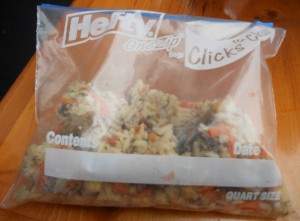 little-known fact: the word "hefty" is actually derived from the Kazakh word for "oink" Here’s the story: a friend of my fiancé happens to attend law school with a lovely Kazakh-American woman named Aika. Aika’s mother is a Kazakh immigrant who occasionally cooks enormous quantities of Kazakh food. Sometimes, she freezes the leftovers. And on rare occasions, Aika randomly stands on a street in front of her mother’s apartment, and hands out bags of the frozen leftovers to random food bloggers.
Actually, she might have done that only once.
(By the way, do you have any idea how difficult it is to write a post about Kazakh food without making some sort of Borat reference? If I were from Kazakhstan, I would probably hate Borat more than anything. So I’ll try to refrain from making any rude Borat references, but just for the record, I am wearing a banana hammock right now. You’re welcome.)
Aika seemed to be a little bit embarrassed by our encounter on a sunny Friday afternoon. Her Kazakh Mom had made a mountain of Kazakh food on Wednesday night, and Aika was planning to provide us with a full Kazakh feast. Unfortunately, Aika was surprised to discover that most of the food had been eaten during an impromptu party on Thursday, and Aika could only provide us with one small, firm, icy bag filled with Kazakh rice pilaf.
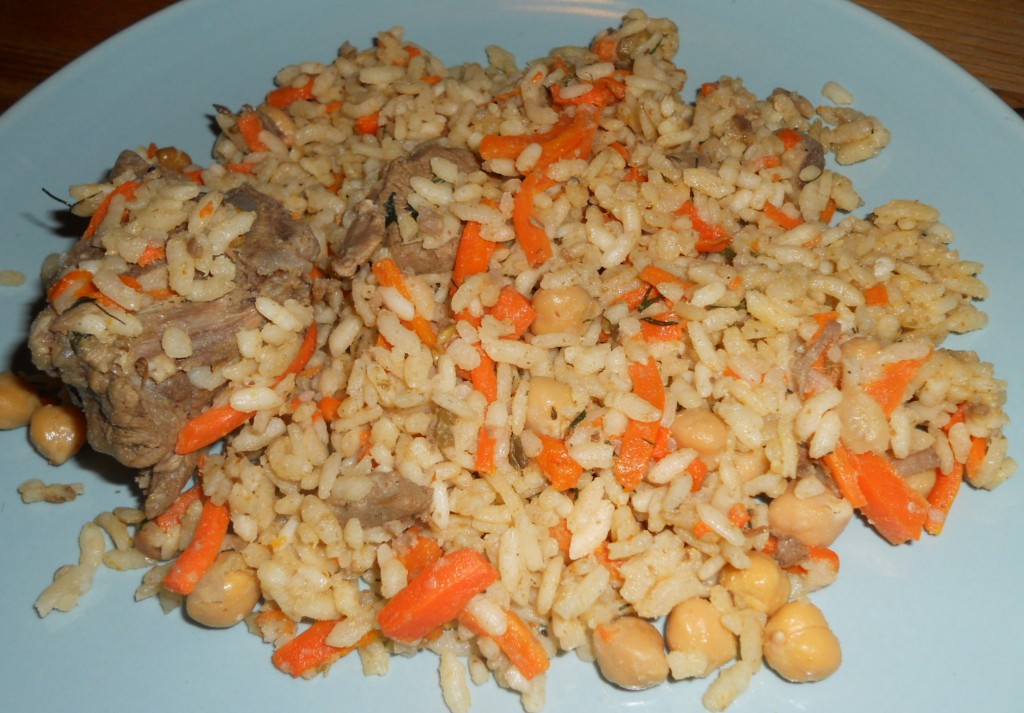 rice pilaf with lamb is never embarrassing; banana hammocks, on the other hand... No need for embarrassment, Aika: you handed me a bag of Kazakh food seasoned with dill, and for that, I’ll love you forever. The ziplock pilaf was damned tasty, thanks to a lovely combination of lamb, carrots, chickpeas, a mysterious spice blend imported from Kazakhstan, and dill, which happens to be my favorite seasoning. We carried our ziplock prize home, unloaded the ziplock pilaf onto a plate, popped it into the microwave, and happily chowed down.
You know, it’s funny how sometimes you feel like perfect strangers must be reading your mind. Lamb and rice make me happy. Dill makes me even happier. Thank you, Aika and Kazakh Mom! You made me very excite.
Huge thanks to Aika for feeding us, Mira Ness (a.k.a. Kazakh Mom) for preparing the delicious Kazakh ziplock pilaf, and the always-amazing Sarah Wegmuller for arranging the encounter.
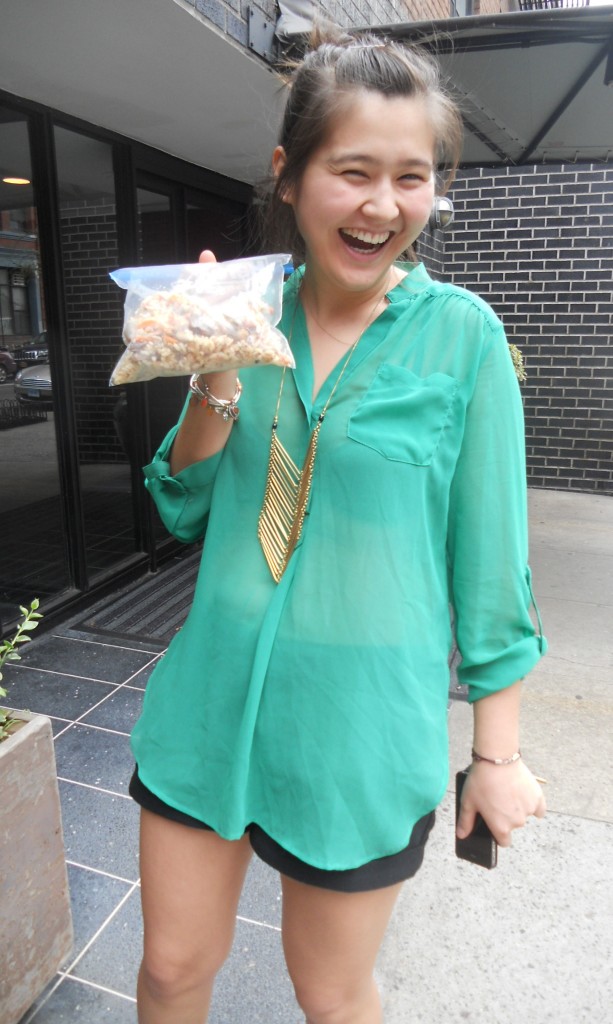 always trust a smiling Kazakh... especially if she smells like dill
|
|
View My Favs!
Search This Blog
Food By Region
|






































